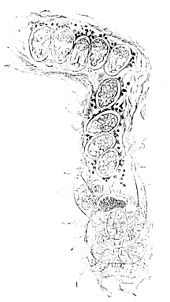but the mode of transmission has been a puzzle, it being observed that among doctors and hospital attendants infection was comparatively rare. This is explained by the nocturnal habits of the mite—or, if not truly nocturnal, its activity is promoted by a certain degree
Fig. 12.—Burrow of Itch-Insect (Sarcoptes scabei).—Female depositing eggs. The eggs lying next to the insect consist partly of an homogeneous, partly of a granular mass: in those distant from the insect embryos are already developed, and at the entrance of the furrow a moving acarus is seen.
of warmth, so that it lies dormant during the day, when the body is cool, to sally forth in search of new fields when stimulated by the genial warmth of the bed. This explains also why the itching is most violent at night. The mode of getting rid of the parasite is obvious; we have only to kill it; and, fortunately, the means is cheap, easily applied, and perfectly effectual: sulphur, which seems to be a deadly bane to all insects, in whatever shape it can be given. It is only necessary to expose the insect to its influence, and it surely dies.
One curious point regarding these mites is, how they produce the physiological effects that characterize their attacks. Their incessant gnawings and nibblings are undoubtedly sufficient to cause great irritation; but there are the different symptoms induced by different species—scurfy, inflamed surfaces, coarse, leprous crusts, deep ulcers, etc.; can these be accounted for by degrees of mechanical irritation, or are they possibly the result of some special poisonous virus? The itch-mite is found on the lion, dog, sheep, ox, horse, pig, and other animals, as well as on man. There are several other species, as the S. scabei-crustosœ, or Norwegian itch-mite, most common in Norway, but not wholly confined to that country. The mite is much like the common species, but smaller and darker. The malady is similar to that of the common itch, though all the symptoms are intensified, the tubercles and crusts growing enormously. It yields, however, to cleanliness and the sulphur treatment. S. cati infests the domestic cat, the points of attack being the base of the nose, the lips, the ears, and the eyes, but spreading in all directions; the animal is reduced to a pitiable condition, being literally devoured alive by the parasites, if not de-

